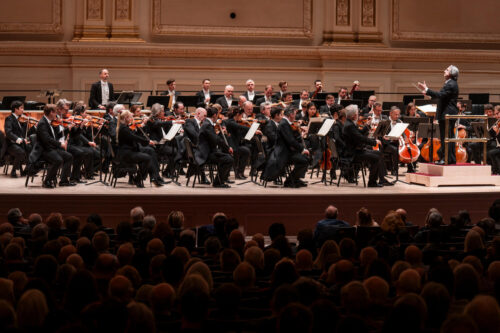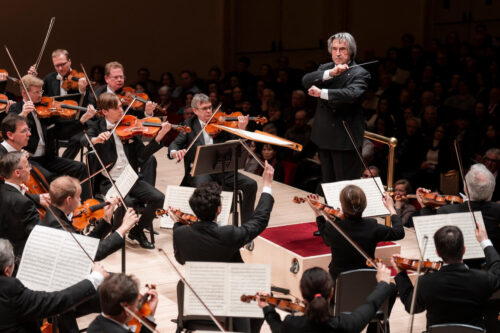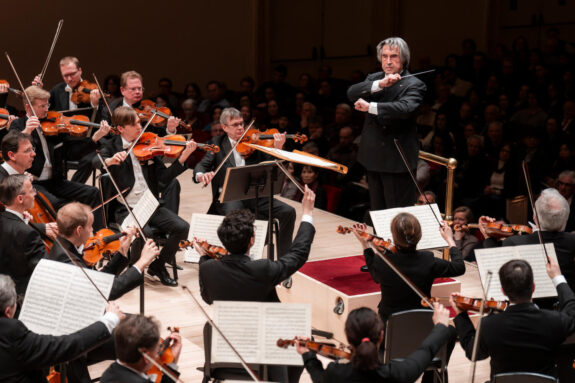 United States Various: Vienna Philharmonic / Riccardo Muti (conductor). Carnegie Hall, New York, 28.2, 1.3 & 2.3.2025. (ES-S)
United States Various: Vienna Philharmonic / Riccardo Muti (conductor). Carnegie Hall, New York, 28.2, 1.3 & 2.3.2025. (ES-S)

28.2. – Schubert, Bruckner
Schubert – Symphony No.4 in C minor, D.417, ‘Tragic’
Bruckner – Symphony No.7 in E major, WAB 107
1.3. – Catalani, Stravinsky, Schubert
Catalani – Contemplazione
Stravinsky – Divertimento from Le baiser de la fée
Schubert – Symphony No.9 in C major, D.944, ‘Great’
2.3. – Mozart, Dvořák
Mozart – Symphony No.41 in C major, K.551, ‘Jupiter’
Dvořák – Symphony No.9 in E minor, Op.95, ‘From the New World’
Encore: Johann Strauss II – Overture to Der Zigeunerbaron
A three-day weekend of performances by the Vienna Philharmonic during spring’s awakening has long been a cherished highlight of the Carnegie Hall season. Each year, the ensemble invites a distinguished conductor to take the helm and to navigate a repertoire that is both familiar and formidable. The pleasure – and challenge – lies in discerning how effectively they define the interpretations while imprinting a personal vision on an ensemble of such stature and deep tradition.
Riccardo Muti, this year’s guest conductor, is a true statesman of the podium, having long balanced tradition with a commanding artistic presence. He wields his baton with the authority of a historian and the conviction of an artist, shaping performances that are disciplined and resistant to fleeting trends. His relationship with the Vienna Philharmonic spans more than five decades, marked by annual collaborations and multiple appearances at Carnegie Hall. However, their last performance together in this venue was in 2006, heightening anticipation for their reunion in a series of programs rich with orchestral masterpieces.
On Friday’s first night, Muti’s rendition of Bruckner’s Symphony No.7 unfolded with grandeur and clarity, emphasizing the composer’s expansive architecture while drawing out an operatic lyricism often overlooked in Bruckner’s symphonies. The Allegro moderato began with luminous warmth, the opening theme in the cellos and violas shaped with a broad, singing line that set the tone for the movement’s unfolding drama. Muti’s careful attention to phrasing allowed the secondary theme’s soaring lines to emerge naturally, with woodwinds and horns adding a near-vocal expressiveness. The brass chorales provided weight without heaviness, reinforcing the music’s stately majesty. However, the pacing, though noble, did not provide a marked enough contrast with the Adagio, blurring the structural delineation between the two movements.
The Adagio – the emotional core of the symphony – was shaped with the unhurried breadth of a tragic operatic soliloquy. The Wagner tubas delivered their mournful lines with burnished depth, their interplay with the strings heightening the expressive contrast between lament and transcendence. The Scherzo had rhythmic bite, its hunting-horn motifs crisply articulated, while the Trio’s evoked a pastoral lightness. In the Finale, themes emerged with operatic clarity. Throughout, the Vienna Philharmonic’s refinement was unmistakable, with individual contributions – particularly from the woodwinds and brass – enriching the symphony’s textures. Muti’s interpretation emphasized beauty, balance and lyricism, though the Sisyphean character of Bruckner’s gradual crescendos was somewhat softened. Likewise, the grandeur at times came at the expense of the deep sense of devotion and transcendence that makes Bruckner’s music unique.

The centerpiece of the second concert was Schubert’s Symphony No.9, a work especially close to the conductor’s heart. His reading was one of refinement and precision, yet one that often-prioritized surface beauty over structural urgency. The Andante introduction unfolded with nobility, the trombones adding measured weight, though the transition to the Allegro ma non troppo felt cautious rather than exhilarating.
One of the evening’s most striking moments came in the Andante con moto: a dramatic cesura that gave way to a tender cello-winds duet, played with great delicacy. Nevertheless, the movement as a whole lacked the underlying tension needed to sustain its forward momentum.
The Scherzo benefited from the Philharmonic’s trademark cohesion, with crisp execution from the strings and warm, blended brass. Yet even here, a tendency to caress details unnecessarily softened its rustic energy. The Finale showcased the orchestra’s polish, though the tempo, never quite pressing forward, left Schubert’s jubilant exuberance somewhat muted. Overall, Muti’s interpretation was undeniably elegant, but its delicacy came at the expense of the symphony’s Flüssigkeit.
The previous evening, Schubert’s more concise Symphony No.4 was rendered in a similar vein, with dramatic urgency and tension often yielding to a focus on lyricism and detail. The performance, preceding Bruckner’s Symphony No.7, highlighted intriguing parallels between the composers’ symphonic approaches, particularly in thematic development. In Muti’s reading of the Schubert, the Adagio molto introduction unfolded with solemnity and measured pacing akin to Bruckner’s expansive openings. This gravitas set the stage for the Allegro vivace, where Schubert’s clear melodic lines and harmonic explorations hinted at the structural complexity Bruckner would later refine, as initial motifs evolved into expansive, cathedral-like musical architectures.
The first half of the performance featured two rarely played works: Alfredo Catalani’s Contemplazione and the Divertimento from Le baiser de la fée by Stravinsky. Muti’s intent to spotlight underrepresented compositions from his native Italy is indeed commendable. However, despite his efforts to highlight the serenity of the extended, ascending melodic lines in a heartfelt rendering by the Viennese strings, the music occasionally veered into overly sentimental territory, bordering on the syrupy and lachrymose.
Stravinsky’s suite from the ballet Le baiser de la fée, presented in its 1949 version, was the sole twentieth-century work performed across the three concerts. As a profound homage to Tchaikovsky – whom Stravinsky greatly admired – the music remains rooted in Romanticism while embracing modernist elements. The Danses suisses section, with its rhythmic and harmonic nods to the revolutionary Petrushka, was particularly noteworthy. Muti deftly balanced Tchaikovsky’s romantic allure with Stravinsky’s ironic modernism, ensuring neither aspect overpowered the other. The performance further showcased the exceptional quality of the Vienna Philharmonic’s individual musicians. The opening Sinfonia featured plaintive flute and oboe interventions. The Danses suisses highlighted engaging exchanges between horns, winds and a string quartet. The concluding Pas de deux was particularly affecting, with a poignant cello solo accompanied by harp.
The final performance of Muti’s Vienna Philharmonic cycle, once again not including a concertante piece, presented two undisputed masterpieces. However, employing an unnecessarily large orchestral ensemble rendered Mozart’s Symphony No.41 ponderous, its weight surpassing even that of the earlier-performed Schubert pieces. This heaviness, more fitting for Bruckner, burdened Mozart’s music, creating an incongruous experience for listeners accustomed to the nimbleness of historically informed performances. Describing the tempi as ‘unhurried’ is an understatement: although this deliberate pacing highlighted the dissonances and clarified each fugal detail, it failed to prevent instances of temporal discordance – a recurring pattern throughout the weekend. As with the Schubert performances, the music seemed veiled by a translucent barrier, dulling its inherent brilliance and charm.
Following the interval, Dvořák’s Symphony No.9 emerged as arguably the highlight of the Vienna Philharmonic’s visit. While expansive, the performance remained dynamically balanced, rich in engaging moments and meticulous detail. The Scherzo was imbued with remarkable vigor and precision, the orchestra capturing the movement’s inherent energy with crisp string articulation and robust, resonant brass. The contrasting Trio section provided a serene interlude, with Muti allowing the woodwinds’ lyrical expressiveness to shine through the inventive melodies. The music’s lyricism was even further substantiated in the Largo, the orchestra navigating the movement’s ebb and flow with grace, while the cor anglais soloist shaped the theme with a hauntingly beautiful tone. From the commanding brass fanfare to its triumphant conclusion, the Allegro con fuoco surged with electrifying intensity, the wealth of thematic material – including the recapitulation of motifs from previous movements – on full display.
Traditionally, especially after a shorter performance, the Vienna Philharmonic offers a waltz as an encore for the eager audience. After a few words in English expressing his hope for ‘Amore, Fratellanza, Pace’ (Italian for ‘Love, Brotherhood, Peace’), Muti conducted – with verve – not a waltz but something close: Johann Strauss II’s Overture to Der Zigeunerbaron. The ovations showed no signs of waning.
Edward Sava-Segal

[Edited] Muti is often rhythmically slack or interpretively bland … the idea that the Jupiter sported an unnecessarily large ensemble is utter tosh, on both historical (Mozart delighted in having very large orchestras, with doubled winds – sadly missing this Sunday – play his symphonies when possible) and aesthetic (the music has plenty of intrinsic weight, sweep, grandeur) grounds. Indeed from the balcony the ensemble was too small to register with much impact. Any ‘ponderousness’ was due to the evident boredom of the orchestra, surely the fault of Muti, whose charge it was to inspire the players.